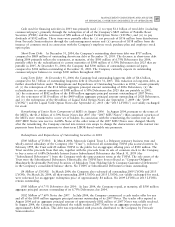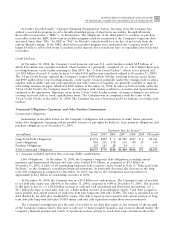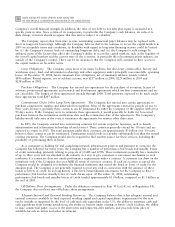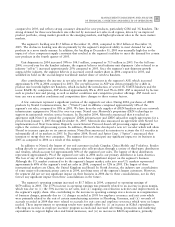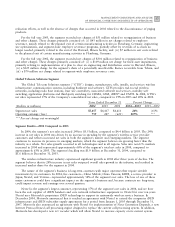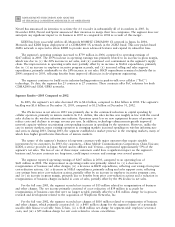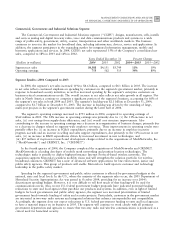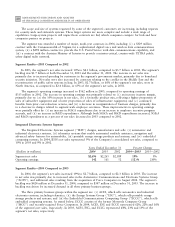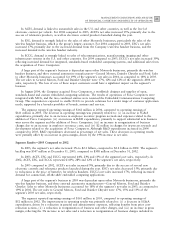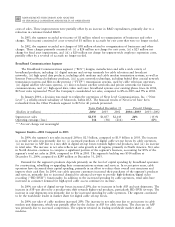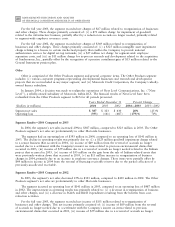Motorola 2004 Annual Report Download - page 63
Download and view the complete annual report
Please find page 63 of the 2004 Motorola annual report below. You can navigate through the pages in the report by either clicking on the pages listed below, or by using the keyword search tool below to find specific information within the annual report.
55
MANAGEMENT'S DISCUSSION AND ANALYSIS
OF FINANCIAL CONDITION AND RESULTS OF OPERATIONS
compared to 2003, and reÖects strong consumer demand for new products, particularly GSM and 3G handsets. The
strong demand for these new handsets was reÖected by increased net sales in all regions, driven by an improved
product portfolio, strong market growth in the emerging markets, and high replacement sales in the more mature
markets.
The segment's backlog was $1.5 billion at December 31, 2004, compared to $2.2 billion at December 31,
2003. The decline in backlog was driven primarily by the segment's improved ability to meet demand for new
products in a more timely manner. In addition, the backlog at December 31, 2003 was unusually high due to the
impact of a key component supply constraint that resulted in the segment's inability to meet the demand for certain
new products in the fourth quarter of 2003.
Unit shipments in 2004 increased 39% to 104.5 million, compared to 75.3 million in 2003. For the full year
2004, a record year for the handset industry, the segment believes total industry unit shipments (also referred to as
industry ""sell-in'') increased approximately 25% compared to 2003. Since the segment's unit shipment growth
outpaced the industry, the segment believes it increased overall market share in 2004 compared to 2003, and
solidiÑed its hold on the second-largest worldwide market share of wireless handsets.
Also contributing to the increase in net sales was the improvement in the segment's ASP, which increased
approximately 15% in 2004 compared to 2003. The overall increase in ASP was driven primarily by a shift in
product mix towards higher-tier handsets, which included the introduction of several 3G UMTS handsets and the
iconic RAZR. By comparison, ASP declined approximately 8% in 2003 and 5% in 2002. ASP is impacted by factors
such as product mix and pricing, as well as market conditions and competitive product oÅerings. ASP trends over
time can vary as market conditions and competition drive changes to these various factors.
A few customers represent a signiÑcant portion of the segment's net sales. During 2004, purchases of iDEN
products by Nextel Communications, Inc. (""Nextel'')and its aÇliates comprised approximately 14% of the
segment's net sales, compared to 18% in 2003. We have been the sole supplier of iDEN handsets and core network
infrastructure equipment to Nextel for over ten years. Nextel uses Motorola's proprietary iDEN technology to
support its nationwide wireless service business. In December 2004, Motorola announced that it reached an
agreement with Nextel to extend the companies' iDEN infrastructure and iDEN subscriber supply agreements for a
period from January 1, 2005 through December 31, 2007. Motorola also announced an agreement with Nextel for
implementation of Next Generation Dispatch, a new Internet Protocol-based call processing engine designed to
replace the current call-processing system. In addition, Motorola has developed a new 6:1 vocoder which will allow
Nextel to increase capacity on its current system. Nextel has announced its intention to activate the 6:1 vocoder in
substantially all of its markets in 2005. In December 2004, Nextel and Sprint Corp. (""Sprint'') announced their
intention to merge their two companies. The segment does not anticipate any signiÑcant impact to its business in
2005 as compared to 2004 as a result of this merger.
In addition to Nextel, the largest of our end customers include Cingular, China Mobile and Vodafone. Besides
selling directly to carriers and operators, the segment also sells products through a variety of third-party distributors
and retailers, which account for approximately 30% of the segment's net sales. The largest of these distributors
represented approximately 5% of the segment's net sales in 2004 and is our primary distributor in Latin America.
The loss of any of the segment's major customers could have a signiÑcant impact on the segment's business.
Although the U.S. market continued to be the segment's largest market, sales into non-U.S. markets represented
approximately 60% of the segment's total net sales in 2004, compared to 52% in 2003. The largest of these
international markets are China, the United Kingdom and Brazil. In North America, the industry saw consolidation
of some major telecommunications carriers in 2004, involving some of the segment's largest customers. However,
the segment did not see any signiÑcant impact on their business in 2004 due to these consolidations, nor do they
foresee any signiÑcant impact from these consolidations in the future.
The segment's operating earnings increased to $1.7 billion in 2004, compared to operating earnings of
$479 million in 2003. The 257% increase in operating earnings was primarily related to an increase in gross margin,
which was due to: (i) the 53% increase in net sales, and (ii) ongoing cost-reduction activities and improvements in
the segment's supply chain. Also contributing to the increase in operating earnings was a decrease in reorganization
of business charges, primarily due to: (i) charges recorded in 2003 for employee severance and exit costs which
were primarily related to the exit of certain manufacturing activities in Flensburg, Germany, and (ii) reversals of
accruals recorded in 2004 that were related to accruals for exit costs and employee severance which were no longer
needed. These improvements to operating results were partially oÅset by: (i) an increase in SG&A expenditures,
reÖecting an increase in employee incentive program accruals and increased advertising, promotion and marketing
expenditures to support higher sales and brand awareness, and (ii) an increase in R&D expenditures, primarily






